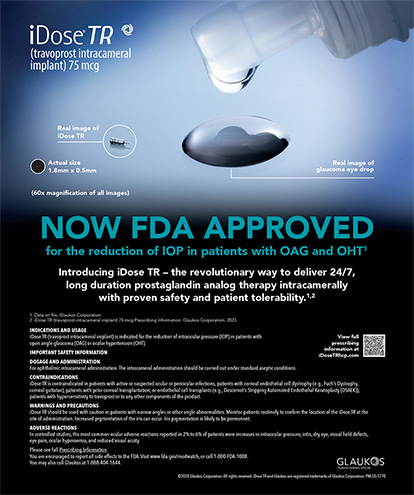I have used the Intralase FS laser (Intralase Corp., Irvine, CA) in 100% of my refractive surgeries for nearly 2 years. This method of flap creation has several advantages compared with mechanical microkeratomes, two of which are increased safety and a reduced rate of enhancements.
EASE OF USEI found the learning curve with the Intralase to be shorter than with any bladed microkeratome I had used. Because 15% to 20% of my patients are Asian, I am particularly impressed with this technology's ability to fit orbits of any size using its standard suction ring and no speculum. I have had no problems in this regard after more than 5,000 cases.
EFFECTSWhen I began using the Intralase, I noticed that my patients seemed to have fewer problems with dry eye than previously. Other surgeons have anecdotally reported similar observations. A study by Daniel Durrie, MD,1 of Overland Park, Kansas, that compared the Intralase FS laser to the Hansatome (Bausch & Lomb, Rochester, NY) showed that the former has a less negative effect on the tear film out to 3 months postoperatively. Although this advantage has yet to be explained, the reason may relate to differences in the characteristics of the flaps each device produces. Those made with the Intralase have a uniform thickness and are thin enough not to affect the corneal nerves. By contrast, the variable thickness of flaps created with a mechanical microkeratome and the fact that the flap's characteristics make it deeper in the periphery where the nerves enter could certainly contribute to this observed affect.
Except when induced by the surgeon, epithelial defects are rare with the Intralase unit, because a laser beam rather than a blade moves across the eye. A microkeratome's blade compresses the cornea before it. If there is epithelial or basement membrane pathology, it will make the epithelium more prone to abrasion. Also, because the Intralase requires less suction than a mechanical microkeratome, the former poses a lesser risk of occluding the central retinal artery and raises IOP to a lower degree. These differences are important in patients with glaucoma or fragile retinal or optic nerve vessels.
VERSATILITYWith the Intralase laser, I can locate the hinge wherever I wish. I vary its position depending on the type of refraction, my own preference, or the axis of astigmatism. As an example, for an eye that has with-the-rule astigmatism, I use a superior hinge, because the long axis of the ablation is horizontal. It is also possible to change the side-cut angle to make it more like that of a traditional microkeratome, which enters the cornea at approximately 26º. I typically set the side-cut angle at 70º so that I can lift and replace the flap similarly to a manhole cover. This side-cut angle promotes centration of the flap and its appropriate replacement. All of these alterations are made with the Intralase's software (Figure 1) rather than through the changing of rings and heads, as with a traditional microkeratome.
REPRODUCIBILITY AND NEUTRALITYWhen I began using the Intralase device, I performed a study of 69 consecutive eyes. My goal was to achieve a 100-µm flap in each case. The average thickness was 103.0 ±10.4µm (range, 86.0 to 124.0 µm). My partner, Perry Binder, MD, of San Diego, has conducted several studies2 showing Intralase flaps to have the narrowest range of thickness (5µm SD versus 8 to 9µm SD with mechanical microkeratomes and a SD of around 10µm).
Interestingly, unlike with a mechanical microkeratome, flaps created with the Intralase unit appear to be neutral regarding refraction and higher-order aberrations. My colleagues and I conducted a study in which we created but did not lift flaps created with the laser. On the subsequent day, we measured the eye's refraction and aberrometry. Like other investigators, we found no statistically significant change. As in my theory regarding postoperative differences in the tear film, the difference in induced aberrations may relate to the Intralase's planar versus mechanical microkeratomes' unevenly thick flaps.
CONCLUSIONIn addition to increasing surgical safety, the Intralase FS laser has decreased the number of enhancements I perform.3 Specifically, my rate decreased from 10% to 7% with the Visx Star S3 laser (Visx, Incorporated, Santa Clara, CA) and 15% to 8% with the Ladarvision 4000 excimer laser (Alcon Laboratories, Inc., Fort Worth, TX). Currently, it is below 3% with the Allegretto Wave excimer laser (Wavelight Laser Technologie AG, Erlangen, Germany). Better outcomes save time and money.
The applications for this technology extend beyond LASIK. It exquisitely creates channels for Intacs segments (Addition Technology, Inc., Des Plaines, IL) and causes less corneal trauma than mechanical means. The device also may be used for lamellar grafts and corneal inlays.
Michael Gordon, MD, is a partner in the Gordon Binder Vision Institute in San Diego. He is an unpaid consultant for Intralase Corp. but has received travel reimbursement. Dr. Gordon may be reached at (858) 455-6800; mgordon786@aol.com.
1. Durrie DS, Kezirian GM. Femtosecond laser versus mechanical keratome flaps in wavefront-guided laser in situ keratomileusis: prospective contralateral eye study. J Cataract Refract Surg. 2005;31:120-126.2. Binder PS. 1000 consecutive flaps with Intralase. Paper presented at: The XXII Congress of the ESCRS; September 18, 2004; Paris, France.
3. Gordon M. Ladarvision 4000 versus Visx Star S3 after the addition of Intralase. Paper presented at: The ASCRS/ASOA Symposium on Cataract, IOL and Refractive Surgery; April 13, 2003; San Francisco, CA.


